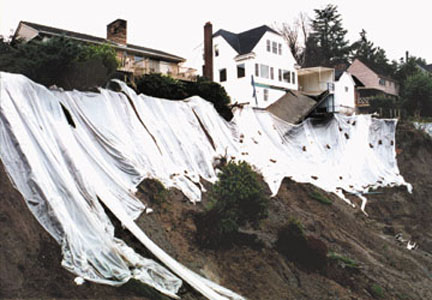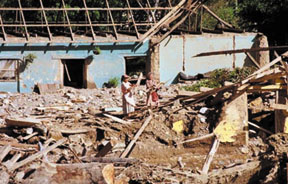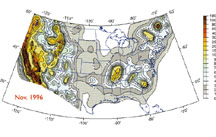A NEW LOOK AT NATURAL DISASTERS

Natural hazards become disasters only when they collide with people.
| Geotimes
Published by the American Geological Institute |
News
and Trends in the Geosciences
April 2000 |
|
A NEW LOOK AT NATURAL DISASTERS by
Timothy A. Cohn and Kathleen K. Gohn
|
 |
|
Natural hazards become disasters only when they collide with people. |
| ABOVE: El Niño brought on heavy rains in 1998 that plagued the northwestern United States with landslides. Pictured is a landslide in Magnolia Bridge, Seattle. The porch at the back of light-colored house was undermined and collapsed. The head of slide was covered with plastic sheets to prevent additional rainwater from entering the slide. Photo courtesy of U.S. Geological Survey |
We are paying a high price for the way we live on our beautiful but dangerous planet. Last year the world experienced deadly earthquakes in Turkey, Taiwan, Colombia and Greece; floods and devastating landslides in Venezuela; hurricanes along the Atlantic Coast that forced evacuation of millions; and numerous smaller disasters. As bad as these events were, they were not extraordinary viewed in the context of previous 20th century occurrences.
The century began with America’s deadliest natural disaster: the 1900 hurricane that hit Galveston, Texas, and killed at least 6,000 people. The 1902 eruption of Mount Pelee on the island of Martinique destroyed the capital city and took more than 30,000 lives. The Tangshan, China, earthquake of 1976 killed at least 300,000 people, and perhaps more than twice that number. In 1998, Hurricane Mitch killed more than 10,000 people in Central America and devastated the regional economy.
While the global death toll remained depressingly high throughout the 20th century, the economic cost of natural disasters has skyrocketed. Seven of the 10 costliest U.S. disasters occurred since 1989. The President’s Office of Science and Technology Policy estimates that, on average, natural disasters cost the United States one billion dollars each week. The floods on the Mississippi in 1993 caused tens of billions of dollars in damages, as did recent California earthquakes and eastern U.S. hurricanes. One such disaster prompted then-Representative Bill Emerson (R-Mo.) and Sen. Ted Stevens (R-Alaska) to note in 1995 that “Hurricane Andrew and California’s Northridge earthquake together cost $24 billion, more than what the government spends annually on running the federal court system, aiding higher education and pollution control, combined.”
| Numerous well-intentioned efforts have attempted to reduce the human and economic costs of natural disasters. However, reducing natural disaster losses is not as simple as it first appears. Structural solutions are often unsatisfactory; the human, environmental and economic cost of attempting to engineer a society completely resistant to natural disasters is too high. The United States, for example, has spent billions of dollars on attempts to control flooding with dams, levees, and channelization. These efforts have not only impaired the functioning of natural ecosystems, but, by altering the floodplain, have, in some cases, actually increased flood peaks downstream. | 
|
Is There
a Solution?
Gilbert White, the author of the first national assessment of natural hazards in 1975, recently wrote: “If the nation is to benefit fully from the growing and deepening knowledge of natural hazards, some effective method must be found to translate that understanding into operative public policy and private procedures.”
In 1997, Public Private Partnership 2000 (PPP2000) was established to seek opportunities for government and private-sector organizations to work together to develop new strategies that will reduce vulnerability to natural hazards in the United States. The partnership is cosponsored by the Subcommittee on Natural Disaster Reduction, a subcommittee of the National Science and Technology Council’s Committee on the Environment and Natural Resources; the Institute for Business and Home Safety, a property/casualty insurance organization dedicated to reducing deaths, injuries, property damage, economic losses and human suffering caused by natural disasters; and more than 20 private-sector organizations.
The creation of PPP2000 recognized that past approaches to reducing
the economic and social impacts of natural hazards cannot fully solve the
problem, which is simply too large and too complex to be handled by any
one group. Developing durable and comprehensive solutions will require
continuing dialog among, and concerted action by, all sectors of our
society.
From 1997 to 1999, the partnership conducted a series of public policy forums, bringing together about 100 stakeholders at each forum to discuss reducing the human and economic toll of natural disasters. The topics ranged from public health aspects of natural disasters to the problems of megacities, from structural design issues to business alliances and financial instruments for risk management.
Mother Nature vs. Human Nature
Much has been learned about specific aspects of natural hazards — for example, the assessment of earthquake hazards, or safe construction of dams. However, while progress in specific technical issues is important, the value of the PPP2000 forums lay in discovering the unexpected patterns and themes that appear when experts in different areas begin to talk to each other.
Natural hazards, which the geologic record shows have been shaping the planet for millions of years, are not a problem to be solved but an essential part of how Earth functions. Ecosystems and individual species have evolved to coexist with them, and preventing their occurrence alters the natural system, often in undesirable ways. In 1996, the Department of the Interior was in the unusual position of creating an artificial flood on the Colorado River to mimic the natural spring floods in order to restore streambanks in the Grand Canyon. Similarly, the U.S. Army Corps of Engineers has recently begun to de-channelize the Kissimmee River in Florida to restore the original flood-based ecosystem the Corps had altered 35 years earlier. Wildland fire and beach erosion are other examples of hazards for which the once-standard approach — controlling natural processes — is now considered economically and environmentally unsound.
Natural hazards become disasters only when they collide with people. It is natural disasters that require solutions, and lasting solutions must be rooted in the realities of human behavior. As FEMA’s Associate Director of Mitigation Mike Armstrong said: “We can’t control mother nature; we can affect human nature.”
Natural disasters are neither acts of God nor simple technical problems. Rather, they result from human decisions about how we choose to live and build. As Dennis Mileti has stated in his 1999 Disasters by Design, natural disasters “are symptoms of broader and more basic problems. Losses from hazards — and the fact that the nation cannot seem to reduce them — result from short-sighted and narrow conceptions of the human relationship to the natural environment.”
| Better information about the natural environment is a key to reducing losses, and we can acquire it in three ways: Improved technology for warning systems will yield immediate benefits (lahar warning systems, for example, are being tested along the slopes of Mount Rainier in Washington state). Assessment of hazards across the nation will allow for better land-use planning, building codes and mitigation. And basic research can lead to fundamental breakthroughs like the theory of plate tectonics, which greatly improved our knowledge of earthquake and volcano hazards. | 
|
While the advances in science and technology have been impressive, their utility depends on educated citizens and policy-makers using this information to make better decisions. As USGS Director Charles “Chip” Groat explains, “science by itself will not protect us. Federal, state and local governments, the private sector, volunteer and charitable organizations and individual citizens must work together in applying the science to make our communities safer.”
The U.S. government plays important roles in protecting its citizens from hazards: providing emergency response and assisting recovery, funding hazards research and collecting and maintaining hazards information. The government should also consider how its decisions influence our vulnerability to hazards. In recent years the government has revisited policies that have created incentives for reckless behavior. For example, well-intentioned government policies related to hazards insurance have sometimes had unfortunate consequences. Some structures have been damaged and rebuilt scores of times; if not for insurance and taxpayer subsidies, the owners of such structures would have been forced to incorporate the true costs of hazards into their decisions about whether to rebuild. Reducing these repetitive losses — which we all pay for — will require a change in government’s role, from one of rescuing victims to one of providing the information people need to protect themselves from future disasters. This change from reaction to prevention will require an investment in research and planning.
Where Do We Go from Here?
We have an opportunity to prevent future natural disasters, rather than just pick up the pieces after disasters strike. Just as we need exercise and good diets, not faster ambulances and sharper scalpels, as a first defense against heart disease, we need to develop good habits about how we live and build on this planet.
The Chairman of the Subcommittee on Natural Disaster Reduction, William H. Hooke, has put forward a “Bill of Rights,” a vision for a world in which natural hazards do not turn into disasters. In this world:
back to Geotimes
home page